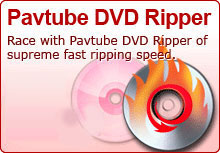-
DVD Ripper
A professional DVD ripping software that help you enjoy favorite DVD movies on portable devices with ease. It supports ripping DVD to AVI, MP4, VOB, MPG, WAV, 3GP, 3G2, WMV, WMA, MOV, MP3, M4A, MP2, AC3, etc. -
DVD to iPod Converter
Pavtube DVD to iPod Converter is easy-to-use application that convert DVD to iPod vide, including MPEG-4 video and H.264 video. It rips fast and smoothly and exports video of total audio/video/ synchronization.
As almost the most popular video formats, AVI stands out of other parallel video formats for its high quality picture and compatibility of multi-operating systems. There is no such a thing that you can be defined as perfect. AVI also has defects, it also has bulk size and what was worse, it does not have unified standard on compression. Chances are Windows of the latest version cannot play AVI with compression of the earlier standards. And thus people always have problem with codecs. They cannot play the AVI files just because they don’t have the correspondingly correct codec, they may have the audio only or other annoying problems. The most direct way to solve this is to find and download the right codec. Although still supported in Windows, and suitable for certain formats like DV, it's not a good general purpose container, and even Microsoft uses other containers for their own video formats.
AVI is not complicated and it was developed for Windows 3.1 in 1992. The most obvious features are high compatibility and easy to use, but these advantages does not prevent us from worrying about the bulk size. That is reason why MPEG-1 and MPEG-4 were created. Compared to the same size of MPEG-2, AVI files are always of much lower quality. That is why people record the AVI video in advance and then convert AVI to MP4, WMV or other kind of videos.
In order for Windows to play an AVI file its necessary to know what decoder on your computer should be used to render the video. AVI files all have a property called a FourCC, which consists of four letters, based on what kind of encoding is used. VfW decoders then register particular FourCCs with Windows, letting it know that they can Decode video in those formats. Some FourCCs correspond to a single application, meaning only one Codec can be used for decoding. Others, like DVSC for DV or any of the standard MPEG-4 FourCCs, can be decoded by a variety of VfW decoders that conform to those standards.
When video enthusiasts began tinkering with MPEG-4 ASP encoding they found that it was possible to store the video in the already deprecated AVI container. Although later on an official MPEG-4 container (MP4) was developed, compatibility with existing tools and VfW codecs has remained popular for MPEG-4 ASP encoding with such codecs as DivX, XviD, and 3ivX.
Uncompressed AVI
AVI files can be created with no Compression, resulting in extremely large file sizes, but with no loss of quality from the input video to the saved file. This also requires no codecs to be installed, either for saving or playback. This is generally not recommended. Instead it's better to use a Lossless Compression format like Huffyuv.
Lossless Compression
If you want to create a smaller AVI than you can get with no compression, but with the highest quality possible, you can also use a lossless codec like HuffYUV or Lagaraith. The files will still be significantly larger than standard compressed files, but good for use as intermediary files for editing and then compressing later.
2009 - 03-03





